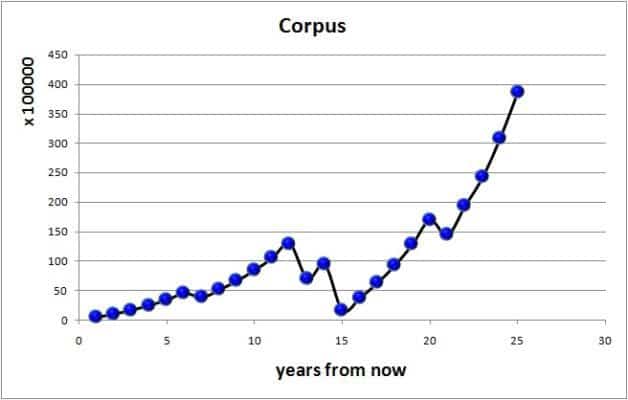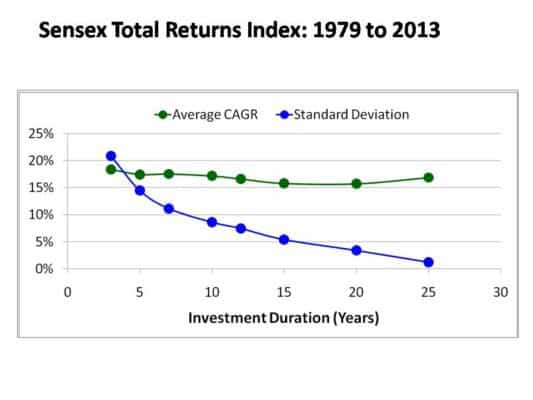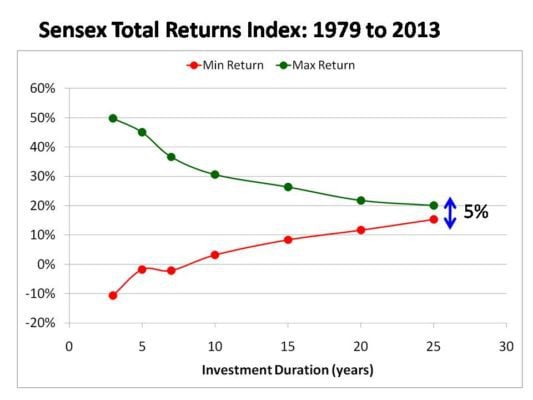Last Updated on November 10, 2024 at 7:27 pm
Nearly three years ago, I was introduced to an interesting idea in goal-based investing by Chenthil Iyer, Horus financials.
You invest a monthly sum of X in a single portfolio for all financial goals. The portfolio is allowed to grow and when the time for each goal arrives, the necessary sum is withdrawn. The final value of the portfolio should be equal to the retirement corpus.
Ideally, the corpus will evolve with time like this
Join 32,000+ readers and get free money management solutions delivered to your inbox! Subscribe to get posts via email! (Link takes you to our email sign-up form)
🔥Want to create a complete financial plan? Learn goal-based investing? Exclusive access to our DIY tools? Increase your income with your skills? Enjoy massive discounts on our robo-advisory tool & courses! 🔥
The dips in value correspond to redemptions made for different financial goals (except retirement).
So the aim is to find the monthly investment X for a given inflation, return and duration for each goal.
I first published a calculator based on this idea in Aug. 31st 2012: Optimize Your Goal Investment Amount
This was followed up with two variants in the Four part series on Goal Based Investing
- Overwhelmed By How Much You Need To Invest For Your Financial Goals? Here Is A Way Out!
- How Achievable Are Your Financial Goals?
All the while I have never been comfortable about this strategy and do not practice it for my goals.
On paper the strategy looks quite impressive for more than one reason:
1) Simplicity. One portfolio. Less number of funds. Less time managing it.
2) The investment amount X in the unified portfolio approach will be significantly lower than the total investment amount if the goals had been treated independently (see why below) . So this makes people sit up, take notice, get motivated and adapt it.
However, it is important to consider the issues associated with such a portfolio.
Some people tend to treat long-term (10Y+) and short-term goals with this approach. This means that a 5 year goal and a 15-year goal will have the same asset allocation.
This is obviously incorrect. So I think the unified portfolio should only be used for long-term goals.
Which brings us to the question:
Are all long-term financial goals the same?
Can you use the same asset allocation for a 10-year goal and 25-year goal? Do they both have the same risk profile? That is in terms of what they mean to you.
I would like to answer this in two ways: (1) with some math and (2) how I personally view it .
Let us start with slides that I use for the investor workshops.
This is the average Sensex CAGr of every 5, 7, 10, 15-year durations between 1979 to 2013. The corresponding standard deviation is also plotted.
The standard deviation is a measure of how much actual returns will deviation from the average. That is, it is the error in the average.
For 5 years, the return is ~ 17% +/- 14%(std dev.) A huge spread in returns.
From 14% for 5 years, the spread drops to about 9% for 10Y, 5% for 15Y and 4% for 20Y.
The same information can also be presented in this way:
Do not make the conclusion that the difference between the maximum and minimum returns will drop to zero with time. It will not. Remember our markets are still too young.
The swing in returns possible for a 10Y goal is considerably different from that a 15Y goal and a 20Y goal.
So it makes no sense (at least to me) to group them together and use the unified portfolio.
So my answer is: not all long-term goals are the same
This is why I prefer to manage them individually under separate portfolios. I may start off with a 60% equity allocation but with time, this will change (decrease) for goals like my son’s education and not retirement. In fact, I now use 100% equity for his marriage (not a top priority to me and I am not investing enough for it. Can’t rather.).
Individual portfolios allow me to track the goals better, take a different and hopefully appropriate amount of risk.
As noted above, the investment required for a unified portfolio is much smaller than for individual portfolios. The reason for that is the unified portfolio takes into account future cash flows.
For example, if my retirement is 25 years away and my son’s college education is 15 years away, I can invest more for retirement after 15 years.
The unified portfolio factors that in now itself. Is this not a smart thing to do?
Not really. We are assuming the future will turn out like it does on an Excel sheet.
I have enough experience to not take that kind of a risk. It is folly to assume future cash inflows can be used the way we want. Life may have other plans for us.
If you do not have enough to invest to for each goal separately, it is okay to use the unified portfolio approach. However, be sure to invest more in future (if and) when you are able to do so.
Also de-risking the corpus (that is reducing equity exposure) a few years before the goal is crucial. This is easier to do with individual folios. You can also start with a single portfolio and branch out before each goal. So many ways to play it.
Is it not hard to manage individual folios? Not if you are a patient investor who takes informed decisions. There are so many folio trackers today that it is not hard at all.
Will not be too many mutual funds? One or two equity funds per goal is not that big a deal.
I write this post as a note of caution.
I recently listened to Dr. Uma Shashikant discuss this method with a group of advisors. Inspired by this, I reworked the above sheets and used it for the Chennai and Hyderabad investor meets.
This is a note of caution for all participants that there are disadvantages associated with this method.
While I do not recommend it, it can serve as a motivation to start investing for goals.
The unified portfolio is now part of the freefincal robo advisor tool.
🔥Enjoy massive discounts on our courses, robo-advisory tool and exclusive investor circle! 🔥& join our community of 7000+ users!
Use our Robo-advisory Tool for a start-to-finish financial plan! ⇐ More than 2,500 investors and advisors use this!
Track your mutual funds and stock investments with this Google Sheet!
We also publish monthly equity mutual funds, debt and hybrid mutual funds, index funds and ETF screeners and momentum, low-volatility stock screeners.





- Do you have a comment about the above article? Reach out to us on Twitter: @freefincal or @pattufreefincal
- Have a question? Subscribe to our newsletter using the form below.
- Hit 'reply' to any email from us! We do not offer personalized investment advice. We can write a detailed article without mentioning your name if you have a generic question.
Join 32,000+ readers and get free money management solutions delivered to your inbox! Subscribe to get posts via email! (Link takes you to our email sign-up form)
About The Author
 Dr M. Pattabiraman(PhD) is the founder, managing editor and primary author of freefincal. He is an associate professor at the Indian Institute of Technology, Madras. He has over ten years of experience publishing news analysis, research and financial product development. Connect with him via Twitter(X), Linkedin, or YouTube. Pattabiraman has co-authored three print books: (1) You can be rich too with goal-based investing (CNBC TV18) for DIY investors. (2) Gamechanger for young earners. (3) Chinchu Gets a Superpower! for kids. He has also written seven other free e-books on various money management topics. He is a patron and co-founder of “Fee-only India,” an organisation promoting unbiased, commission-free investment advice.
Dr M. Pattabiraman(PhD) is the founder, managing editor and primary author of freefincal. He is an associate professor at the Indian Institute of Technology, Madras. He has over ten years of experience publishing news analysis, research and financial product development. Connect with him via Twitter(X), Linkedin, or YouTube. Pattabiraman has co-authored three print books: (1) You can be rich too with goal-based investing (CNBC TV18) for DIY investors. (2) Gamechanger for young earners. (3) Chinchu Gets a Superpower! for kids. He has also written seven other free e-books on various money management topics. He is a patron and co-founder of “Fee-only India,” an organisation promoting unbiased, commission-free investment advice.Our flagship course! Learn to manage your portfolio like a pro to achieve your goals regardless of market conditions! ⇐ More than 3,000 investors and advisors are part of our exclusive community! Get clarity on how to plan for your goals and achieve the necessary corpus no matter the market condition is!! Watch the first lecture for free! One-time payment! No recurring fees! Life-long access to videos! Reduce fear, uncertainty and doubt while investing! Learn how to plan for your goals before and after retirement with confidence.
Our new course! Increase your income by getting people to pay for your skills! ⇐ More than 700 salaried employees, entrepreneurs and financial advisors are part of our exclusive community! Learn how to get people to pay for your skills! Whether you are a professional or small business owner who wants more clients via online visibility or a salaried person wanting a side income or passive income, we will show you how to achieve this by showcasing your skills and building a community that trusts and pays you! (watch 1st lecture for free). One-time payment! No recurring fees! Life-long access to videos!
Our new book for kids: “Chinchu Gets a Superpower!” is now available!


Must-read book even for adults! This is something that every parent should teach their kids right from their young age. The importance of money management and decision making based on their wants and needs. Very nicely written in simple terms. - Arun.Buy the book: Chinchu gets a superpower for your child!
How to profit from content writing: Our new ebook is for those interested in getting side income via content writing. It is available at a 50% discount for Rs. 500 only!
Do you want to check if the market is overvalued or undervalued? Use our market valuation tool (it will work with any index!), or get the Tactical Buy/Sell timing tool!
We publish monthly mutual fund screeners and momentum, low-volatility stock screeners.
About freefincal & its content policy. Freefincal is a News Media Organization dedicated to providing original analysis, reports, reviews and insights on mutual funds, stocks, investing, retirement and personal finance developments. We do so without conflict of interest and bias. Follow us on Google News. Freefincal serves more than three million readers a year (5 million page views) with articles based only on factual information and detailed analysis by its authors. All statements made will be verified with credible and knowledgeable sources before publication. Freefincal does not publish paid articles, promotions, PR, satire or opinions without data. All opinions will be inferences backed by verifiable, reproducible evidence/data. Contact information: To get in touch, use this contact form. (Sponsored posts or paid collaborations will not be entertained.)
Connect with us on social media
- Twitter @freefincal
- Subscribe to our YouTube Videos
- Posts feed via Feedburner.
Our publications
You Can Be Rich Too with Goal-Based Investing
 Published by CNBC TV18, this book is meant to help you ask the right questions and seek the correct answers, and since it comes with nine online calculators, you can also create custom solutions for your lifestyle! Get it now.
Published by CNBC TV18, this book is meant to help you ask the right questions and seek the correct answers, and since it comes with nine online calculators, you can also create custom solutions for your lifestyle! Get it now.Gamechanger: Forget Startups, Join Corporate & Still Live the Rich Life You Want
 This book is meant for young earners to get their basics right from day one! It will also help you travel to exotic places at a low cost! Get it or gift it to a young earner.
This book is meant for young earners to get their basics right from day one! It will also help you travel to exotic places at a low cost! Get it or gift it to a young earner.Your Ultimate Guide to Travel
 This is an in-depth dive into vacation planning, finding cheap flights, budget accommodation, what to do when travelling, and how travelling slowly is better financially and psychologically, with links to the web pages and hand-holding at every step. Get the pdf for Rs 300 (instant download)
This is an in-depth dive into vacation planning, finding cheap flights, budget accommodation, what to do when travelling, and how travelling slowly is better financially and psychologically, with links to the web pages and hand-holding at every step. Get the pdf for Rs 300 (instant download)


